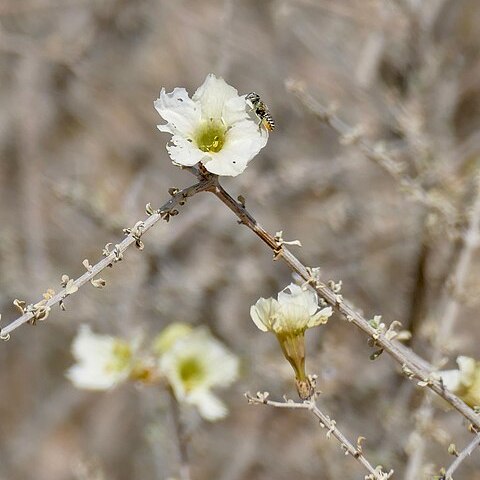Calyx 5–8 mm. long, irregularly 5-lobed; lobes more or less cuspidate, sometimes with prominent ribs, hairy to subglabrous, Corolla white, whitish-pink or pink; tube c. 17 mm. long, funnel-shaped, lower part cylindric and enclosed in the calyx, glabrous outside, hairy inside below the insertion of the stamens; lobes c. 10 mm., in diam., subcircular crenulate, spreading.
Shrub, 1-2 m high. Stems trichotomously branched, branches rigid, spine-tipped. Leaves simple, solitary or fascicled; blade spathulate, apex rounded, margin undulate, gland dotted; sessile or shortly petiolate. Flowers: usually terminal; corolla white or whitish pink to pink; Sep.-Mar.
Small, woody, grey-green shrub, up to 1.5 m tall, sprouting from creeping underground stems. Leaves scattered in small dense tufts on 3-branched stems with pointed tips. Flowers trumpet-shaped, 20-40 mm long, white or rarely pale pink. Fruit narrow and flattened, seeds papery winged.
Leaves 7–20 × 2–4 mm., simple, solitary or clustered up to 10 on each cushion, spatulate to spathulate-oblong, rounded or slightly emarginate, rarely acute at the apex, tapering at the base, gland dotted, margins undulate, glabrous; sessile or shortly petiolate.
Stamens adnate to the corolla tube, and up to 5–8 mm. from the base; filament 8–10 mm. long; anthers c. 4 mm. long, apiculate.
Flowers usually terminal, rarely on lateral cushions, solitary or fascicled; pedicels 1–3 mm. long.
Young branchlets greyish, at first with dense pubescence, with age glabrescent to glabrous.
Erect shrub 1–2(4) m. tall with ternate spiniform branches.
Capsule 6–9 × 1–1.4 cm., long, beaked.
Ovary 2–4 mm. long.
Seeds not seen.

